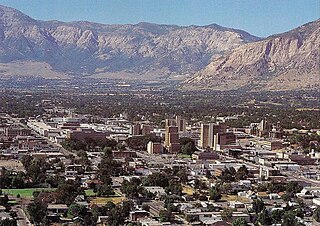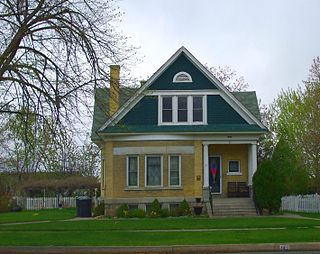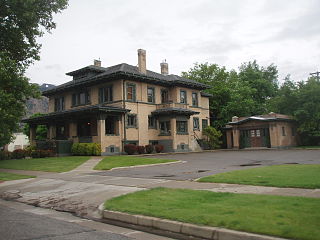Heber Scowcroft House | |
 The house in 2009 | |
| Location | 795 24th Street, Ogden, Utah |
|---|---|
| Coordinates | 41°13′18″N111°57′31″W / 41.22167°N 111.95861°W Coordinates: 41°13′18″N111°57′31″W / 41.22167°N 111.95861°W |
| Area | 0.3 acres (0.12 ha) |
| Built | 1909 |
| Architect | Moroni Charles Woods |
| Architectural style | Colonial Revival |
| NRHP reference # | 91001818 [1] |
| Added to NRHP | December 13, 1991 |
The Heber Scowcroft House is a historic two-story house in Ogden, Utah. It was built in 1909 for Heber Scowcroft, an immigrant from England who moved to Utah with his family in 1880 after converting to The Church of Jesus Christ of Latter-day Saints. [2] Scowcroft later worked as the vice president of John Scowcroft and Son, a wholesale dry goods company founded by his father and based in the Scowcroft Warehouse. [2] The house was designed in the Colonial Revival style by architect Moroni Charles Woods. [2] It has been listed on the National Register of Historic Places since December 13, 1991. [1]

Ogden is a city and the county seat of Weber County, Utah, United States, approximately 10 miles (16 km) east of the Great Salt Lake and 40 miles (64 km) north of Salt Lake City. The population was 84,316 in 2014, according to the US Census Bureau, making it Utah's 7th largest city. The city served as a major railway hub through much of its history, and still handles a great deal of freight rail traffic which makes it a convenient location for manufacturing and commerce. Ogden is also known for its many historic buildings, proximity to the Wasatch Mountains, and as the location of Weber State University.

The Church of Jesus Christ of Latter-day Saints, often informally known as the LDS Church or Mormon Church, is a nontrinitarian, Christian restorationist church that is considered by its members to be the restoration of the original church founded by Jesus Christ. The church is headquartered in Salt Lake City, Utah in the United States, and has established congregations and built temples worldwide. According to the church, it has over 16 million members and 65,000 full-time volunteer missionaries. In 2012, the National Council of Churches ranked the church as the fourth-largest Christian denomination in the United States, with over 6.5 million members there as of January 2018. It is the largest denomination in the Latter Day Saint movement founded by Joseph Smith during the early 19th century period of religious revival known as the Second Great Awakening.

The Scowcroft Warehouse is a historic building in Ogden, Utah. It was built as a four-story warehouse with a basement in 1900 for John Scowcroft and Sons, whose founder John Scowcroft converted to The Church of Jesus Christ of Latter-day Saints in England before immigrating to Utah with his family in 1880. He was the founder and namesake of this dry goods wholesale company in Ogden, and he was also a director of a beetroot sugar manufacturer in Northern Utah called the Ogden Sugar Company, which later merged with several companies to become the Amalgamated Sugar Company. The factory has been listed on the National Register of Historic Places since November 30, 1978.

















